VBQs Human Reproduction Class 12 Biology with solutions has been provided below for standard students. We have provided chapter wise VBQ for Class 12 Biology with solutions. The following Human Reproduction Class 12 Biology value based questions with answers will come in your exams. Students should understand the concepts and learn the solved cased based VBQs provided below. This will help you to get better marks in class 12 examinations.
Human Reproduction VBQs Class 12 Biology
Very Short Answer Type Question
Question. Differentiate between spermatogenesis and spermiogenesis.
Answer :
| S.No. | Spermatogenesis | Spermiogenesis |
| (i) | Production of sperms (by meiosis). | Spermatids are transformed to spermatozoa. |
Question. When do the oogenesis and the spermatogenesis initiate in human females and males, respectively ?
Answer : Oogenesis starts in female in their foetal stage while spermotogenesis in males starts at puberty.
Question. Where is acrosome present in humans ? Write its function.
Answer : It is present at the tip or head of the sperm. It helps to penetrate through the zona pellucida in human ovum.
Question. Where is acrosome present in humans ? Write its functions.
Answer : The acrosome is a cap like structure, present in the head region of human sperm. It contains enzymes which help in dissolving the envelop of ovum to facilitate the entry of sperm into the ovum through zona pellucida and plasma membrane.
Question. Write the effect of the high concentration of L.H. on a mature graafian follicle.
Answer : Rupture of graafian follicle, release of ovum / oocyte / ovulation.
Detailed Answer :
High level of LH induces rupture of graafian follicle so as to release the secondary oocyte or ovum from the ovary by a process called ovulation.
Short Answer Type Question
Question. How is ‘oogenesis’ markedly different from ‘spermatogenesis’ with respect to the growth till puberty in the humans ?
Answer : Oogenesis is initiated at the embryonic stage.
Spermatogenesis begins only at puberty.
Question. Mention the relationships between pituitary and ovarian hormones during a menstrual cycle.
Answer : FSH stimulate follicular development and secretion of estrogen.
LH induces ovulation and development of corpus luteum which secretes progesterone.
Question. (i) Arrange the following hormones in sequence of their secretion in a pregnant woman.
(ii) Mention their source and the function they perform : hCG; LH; FSH; Relaxin.
Answer : (i) FSH, LH, hCG, relaxin (all four hormones in correct sequence = (1 if less than four correct = ½)
(ii) FSH : Anterior pituitary, stimulates follicular development
LH : Anterior pituitary, rupture of Graafian follicle to release ovum / ovulation / dev. of corpus luteum
Question. (i) How many primary follicles are left in each ovary in a human female at puberty ?
(ii) Draw a sectional view of the ovary showing the different follicular stages of a human female in her pre-ovulatory phase of menstrual cycle.
Answer : (i) 60000-80000 primary follicles
(ii)

Question. Explain the events in a normal woman during her menstrual cycle on the following days :
(i) Pituitary hormone levels from 8 to 12 days
(ii) Uterine events from 13 to 15 days
(iii) Ovarian events from 16 to 23 days.
Answer : (i) FSH and LH levels – low
(ii) Endometrium is highly vascularised, proliferative phase of uterine lining.
(iii) Formation of corpus luteum, secretion of progesterone.
Question. Draw a diagram of a mature sperm. Label any three parts and write their functions.
Answer :
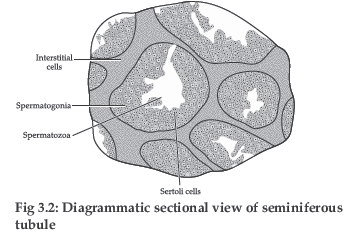
Plasma membrane : Envelope of the sperm
Acrosome : Filled with enzyme that help fertilization of ovum
Mitochondria : Energy source for swimming
Middle Piece : Possess mitochondria which is the energy source for swimming
Tail : For movement of sperm
Nucleus : Containing chromosomal material (Functions of the parts labelled)
Question. Identify A, B, C and D with reference to gametogenesis in humans in the flow chart given below :

Answer : A – Pituitary
B – FSH
C – Spermatogenesis
D – Spermiogenesis
Long Answer Type Questions
Question. (i) Explain the menstrual phase in a human female. State the levels of ovarian and pituitary hormones during this phase.
(ii) Why is follicular phase in the menstrual cycle also referred as proliferative phase ? Explain.
(iii) Explain the events that occur in a graafian follicle at the time of ovulation and thereafter.
(iv) Draw a graafian follicle and label antrum and secondary oocyte.
Answer : (i) Menstrual phase occurs when released ovum not fertilised, break down of endometrial
lining (of the uterus) and its blood vessel form the liquid that comes out through the vagina ,lasts for 3 to 5 days. Level of ovarian and pituitary hormones fall
(ii) Primary follicle grows into graafian follicle under the influence of LH & FSH, regeneration of endometrium (under the influence of estrogen).
(iii) Graafian follicle ruptures to release the ovum (secondary oocyte) , remaining parts of the Graafian follicle transform into corpus luteum.
(iv)
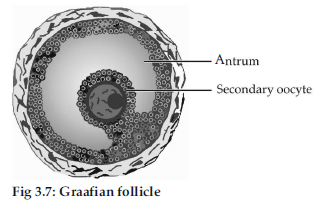
Detailed Answer :
(i) Menstrual phase is the first phase of menstrual or sexual cycle of human females and all related primates.
It begins at puberty. The first menstruation that begins at puberty is called Menarche.
The cycle of events, starting from one menstruation till the next one is called menstrual cycle. In human females, menstruation occurs once in 28 to 29 days. These changes are brought about by ovarian and pituitary hormones.
Menstrual phase refers to the beginning of menstruation wherein the endometrium along with its rich blood supply is shed (menses).
During this phase, the levels of both the ovarian and the pituitary hormones are low.
The level of follicle stimulating hormone starts to increase during the later stages of this phase.
(ii) The menstrual phase is followed by the follicular phase wherein the primary follicles mature into the Graafian follicle under the influence of FSH and LH. The developing follicles release oestrogen which causes the regeneration of the endometrium. Since, the follicles and the endometrium proliferate during the follicular phase; it is also known as proliferative phase.
(iii) At the time of ovulation, the release of gonadotrophins (LH and FSH) increases. The LH and FSH are at their peak in the middle of the cycle (14th day). The increased level of LH causes the rupturing of Graafian follicle and release of ovum into the fallopian tube. The release of ovum from ruptured Graafian follicle is known as ovulation. The remains of the Graafian follicle get converted into the corpus luteum, which secretes progesterone for the maintenance of the endometrium in case of pregnancy.
Question. (i) Where does spermatogenesis occur in human testis ? Describe the process of spermatogenesis upto the formation of spermatozoa.
(ii) Trace the path of spermatozoa from the testis upto the ejaculatory duct only.
Answer : (i) Seminiferous tubules

(ii) Seminiferous tubules → rete testis → Vasa efferentia → Epididymis → vas deferens → (ejaculatory duct)
Detailed Answer :
(i) Spermatogenesis
(a) It is the process of formation of sperms in seminiferous tubules of testis.
(b) It has two stages namely, Formation of spermatids and Spermiogenesis
(c) In the formation of spermatids, the spermatogonia i.e., Sperm mother cells or immature male germ cells produce spermatids.
(d) In spermiogenesis, the spermatids are transformed into sperm.
(ii) As above
Question. Differentiate between spermatogenesis and oogenesis.
Answer : Oogenesis is different from that of spermatogenesis in the following ways: –
(a) In spermatogenesis, continuous production of sperms takes place from puberty to old age. Whereas, in oogenesis, the oocytes are generated before birth/ in the foetus.
(b) A large number of these oocytes degenerate during the phase from birth to puberty. The oocytes continuously decrease in number and it gets completely exhausted at menopause. (c) A primary spermatocyte completes the first meiotic division leading to formation of two equal sized secondary spermatocytes whereas, Primary oocyte divides unequally by the first meiotic division resulting in the formation of a large haploid secondary oocyte and a tiny first polar body.
(d) Meiotic division of secondary oocyte gets temporarily arrested at Prophase-I stage.
It is completed only when a sperm comes in contact with the zona pellucida layer of the ovum. There is no such event in spermatogenesis.
(e) Spermatogonium produces 4 functional spermatozoa whereas an oogonium produces one functional ovum and 3 non-functional polar bodies.
Question. (i) Name the hormone that initiates spermatogenesis in humans. Describe the process of spermatogenesis in sequence mentioning the ploidy of the cells at each step.
(ii) Draw the diagram of a mature human sperm and label the parts that
(a) helps it reaching to the ovum.
(b) providing energy for it to reach the ovum.
(c) helping it to gain entry into the ovum.
Answer : (i) Gonadotropin releasing hormone/ GnRH.
Process of spermatogenesis :
(a) The spermatogonia (present on inside wall of seminiferous tubules) are diploid (2N).
(b) Primary spermatocytes undergo Ist meiosis leading to the formation of two equal haploid cells (N) called secondary spermatocyte.
(c) The secondary spermatocytes undergo the second meiotic division to form 4 equal haploid (N) spermatids.
(d) Now spermatids transform into spermatozoa (N)
(ii)
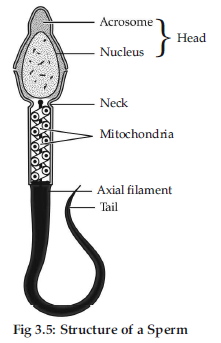
(a) Tail
(b) Middle piece/mitochondria
(c) Acrosome
Question. (i) Explain the hormonal regulation of spermatogenesis in humans.
(ii) Draw the diagram of a human sperm. Label and write the functions of the components of its head.
Answer : (i) Initiation by GnRH from hypothalamus which acts on Anterior lobe of Pituitary gland to release FSH & LH (Gonadotropins)
LH acts on cells of Leydig / Interstitial cells to secrete androgens.
Androgens in turn stimulates the process of spermatogenesis.
FSH acts on Sertoli cells and stimulates the secretions of some factors that stimulate spermiogenesis.
(ii)
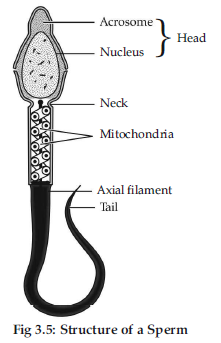
Function of plasma membrane : Envelopes the whole body of sperm.
Acrosome : Contains enzymes for fertilization.
Nucleus : Contains haploid chromosomal material.
Question. (i) Draw a sectional view of a seminiferous tubule of human. Label sertoli cell, spermatogonia and leydig cell on it and write their functions.
(ii) Explain the role of pituitary and sex hormones in the process of spermatogenesis.
Answer : (i)

Functions : Sertoli cells – secrete factors which help in the process of spermiogenesis/provide nutrition to germ cells.
Spermatogonia – divide to produce spermatids /sperms.
Leydig cells – synthesis or secretion of androgens/testosterone.
(ii) Pituitary hormones – LH (luteinising hormone) – acts on Leydig cells and stimulates synthesis and secretion of androgens.
FSH/follicle stimulating hormone – acts on sertoli cells and simulates secretion of some factor that help in spermiogenesis.
Sex hormone – (Androgen/testosterone) stimulate process of spermatogenesis.
Question. Explain the ovarian and uterine events that occur during a menstrual cycle in a human female, under the influence of pituitary and ovarian hormones respectively.
Answer : Menstrual cycle is the reproductive cycle in all primates and begins at puberty (menarche). In human females, menstruation occurs once in 28 to 29 days. The cycle of events starting from one menstruation till the next one is called the menstrual cycle. During the middle of the menstrual cycle, one ovum is released (ovulation). The cycle starts with the menstrual flow (3 to 5 days), caused due to the breakdown of the endometrium of the uterus. Blood vessels ruptures, causing bleeding. But this occurs only when the ovum is not fertilised.
It is followed by the follicular phase where the primary follicles mature into Graafian follicles. This causes the regeneration of the endometrium. These changes are brought about by ovarian and pituitary hormones. In this phase, the release of gonadotropins (LH and FSH) increases. This causes follicular growth and the growing follicles produce oestrogen. The LH and FSH are at their peak in the middle of the cycle (14th day) and cause the rupture of the Graafian follicles to release ovum. This phase is called the ovulatory phase. The remains of the Graafian follicles get converted into the corpus luteum, which secretes progesterone for the maintenance of the endometrium. In the absence of fertilisation, the corpus luteum degenerates, thereby causing the disintegration of the endometrium and the start of a new cycle.
Question. (i) Draw a diagram of a human sperm. Label the different components in its head and middle piece region.
(ii) Explain the process of fertilisation in human female.
Answer : (i)

Any 6 correct labelling in head and middle piece
(ii) A sperm comes in contact with zona pellucida layer of ovum and induces changes in the membrane that block the entry of additional sperm, secretions of acrosome help the sperm to enter into cytoplasm of ovum (through zona pellucida and plasma membrane), this induces completion of unequal meiotic
division of secondary oocyte which leads to formation of a second polar body and haploid ovum, soon haploid nucleus of sperm and ovum fuse to form zygote (fertilization).
Question. (i) Explain the following phases in the menstrual cycle of a human female :
(a) Menstrual phase
(b) Follicular phase
(c) Luteal phase
(ii) A proper understanding of menstrual cycle can help immensely in family planning. Do you agree with the statement ? Provide reasons for your answer.
Answer : (i) (a) Menstrual phase : First 3-5 days of the cycle where menstrual flow occurs due to break down of endometrial lining of uterus, if the released ovum is not fertilised
(b) Follicular phase : From 5th to 14th day of the cycle where the primary follicles grow to become a fully mature Graafian follicle, endometrium of uterus regenerates, Graafian follicle ruptures to release ova (ovulation on 14th day)
(c) Luteal Phase : During 15th to 28th day, remaining parts of graafian follicle transform into corpus luteum, secretion of progesterone (essential for maintenance of endometrium)
All these phases are under the influence of varying concentrations of pituitary and ovarian hormone
(ii) Yes, can take appropriate precautions between 10th to 17th day of the menstrual cycle when the chances of fertilisation are high.
Question. (i) Draw a diagrammatic sectional view of a seminiferous tubule (enlarged) of human male and label
(i) Spermatogonium
(ii) Sertoli cell,
(iii) Primary spermatocyte.
Write the function of each labelled part.
(ii) Differentiate between spermatogenesis and spermiogenesis.
Answer : (i)

Spermatogonium – multiply by mitotic division to increase in number.
Sertoli cells – provide nourishment to developing sperms.
Primary spermatocytes – undergo meiosis to form haploid secondary spermatocytes.
(ii) Spermatogenesis – Development of sperms in testis from spermatogonium.
Spermiogenesis – Maturation of spermatids into spermatozoa / sperms.
Question. (i) Draw diagrammatic sectional view of the female reproductive system of human and label the parts :
(a) Where the secondary oocytes develop
(b) Which helps in collection of ovum after ovulation
(c) Where fertilization occurs.
(d) Where implantation of embryo occurs.
(ii) Explain the role of pituitary and the ovarian hormones in menstrual cycle in human females.
Answer : (i) (a) Ovary
(b) Fimbriae
(c) Isthmus and ampulla junction
(d) Endometrium
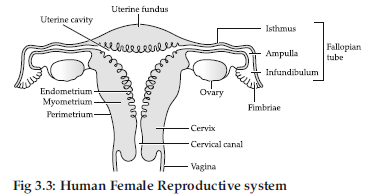
(ii) (a) Role of pituitary hormones : FSH (Follicular Stimulating Hormone) and LH (Luteinising hormone) are the pituitary hormones which are secreted during menstrual cycle in human females. FSH stimulates the growth of primary oocyte into secondary oocyte and graafian follicle while LH induces ovulation.
(b) Role of ovarian hormones : Oestrogen and progesterone are the ovarian hormones.
Oestrogen stimulates the proliferation of endometrium of uterine wall, while progesterone has an important role in the maintenance of endometrium for implantation of fertilized ovum and in other events of pregnancy.